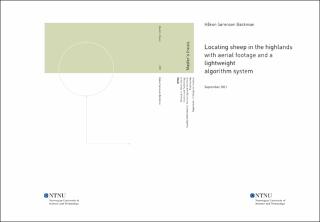| dc.contributor.advisor | Hvasshovd, Svein-Olaf | |
| dc.contributor.author | Sørensen Bøckman, Håkon | |
| dc.date.accessioned | 2022-03-12T18:19:45Z | |
| dc.date.available | 2022-03-12T18:19:45Z | |
| dc.date.issued | 2021 | |
| dc.identifier | no.ntnu:inspera:80723919:34560161 | |
| dc.identifier.uri | https://hdl.handle.net/11250/2984882 | |
| dc.description.abstract | Utfordringene som dagens sauebønner møter i sitt yrke er fysisk tungt og tregt arbeid og arbeidsoppgaver som burde tilhører fortiden.
En av de større utfordringene en sauebonde møter er under innsamling av sau om høsten fra fjellet. Enkelte dyr går seg vill i løpet av sesongen og bonden må finne disse.
I 2017 var tap av dyr på fritt beite 13\% , av forskjellige grunner.
Bonden er pålagt av loven å måtte dokumentere utfallet av vært enkelt dyr, noe som kan ofte bli en lang og dyr prosess.
Siden sauene beveger seg over store beiteområder som er store landområder kan det ofte ta sauebonden flere dager og mange dagsverk før bonden finner det bortglemte dyret.
Bruken av unmanned aerial vehicles (UAV) i kommersiell sammenheng har økt over årene. Bruken øker siden UAV komponenter blir stadig billigere og mindre. UAV'er har en god utviklings plattform for nye kommersielle løsninger siden de er nokså billige, har en lav risiko for personell og egner seg godt for bildegjenkjenningssystem da de ofte er elektriske, stødige og alltid mobile.
I dag er det flere løsninger av denne typen i bruk i jordbruk, inspeksjon avhøyspentkabel og i redningsoperasjoner i Norge.
I denne oppgaven sikter jeg meg inn på å utforske det mulige potensialet ved å bruke en lettvekts algoritme for gjenkjenning av sauer på beite i fjellet, hvor dronen kan drifte systemet av seg selv.
Dronen er utstyrt med et høyoppløsnings kamera som tar 12Mp RGB bilder og et sekundært linse som tar 0.307Mp Infrarøde bilder.
Dronen har blitt brukt av tidligere studenter ved innsanking av data.
Jeg har valgt et toppmoderne CNN (konvulsjon neuralt nettverk) som heter EfficientNet. Som gir lovende resultater på \(\approx\) 95\% nøyaktig på tvers av de forskjellige nettverkene med de forskjellige preprosessering steg. | |
| dc.description.abstract | The challenges the sheep farmer is facing in today's husbandry are physical heavy, slow work and it belongs to the time of the past.
One of the larger challenges the farmer is facing is when he or she are rounding up the animals from the pastures in the highlands in the fall.
Certain amount of animals get lost and the farmer needs to acquire them.
As of 2017 13\% on average animals national wide are lost in a season, due to various reasons.
The farmer is bound by law to document and follow through on each animal, this can often be a lengthy and costly process.
Since the sheep travels across large pastures which are vast areas of land it can take several days and many man-days for a farmer to find the lost animals.
The usage of unmanned aerial vehicles (UAV) in commercial use have increased over the years, where its applications are ever so increasing as the UAVs components get more affordable and smaller.
UAVs are a capable development platform for new applications as they are fairly inexpensive, comes with low risk to personnel, well suited for image recognition systems as they are often electric powered, steady and increasingly mobile.
Today there is found several uses of this type in agriculture, power line maintenance and search and rescue in Norway.
In this thesis I aim to explore the potential possibilities of a using an light weight image recognition algorithm for identifying sheep on the pasture in the highlands, which a drone can carry and power by itself.
The drone is equipped with a high resolution camera taking 12Mp RGB pictures and a secondary lens taking 0.307MP Infra Red pictures.
The drone is operated with previously students, when collecting data.
I choose a state of the art classification CNN(Convolution neural network) called EfficientNet. Which gives a promising results of \(\approx 95\% \) accuracy across the different networks, with different preprocessing steps. | |
| dc.language | eng | |
| dc.publisher | NTNU | |
| dc.title | Locating sheep in the highlands with aerial footage and a lightweight algorithm system. | |
| dc.type | Master thesis | |
